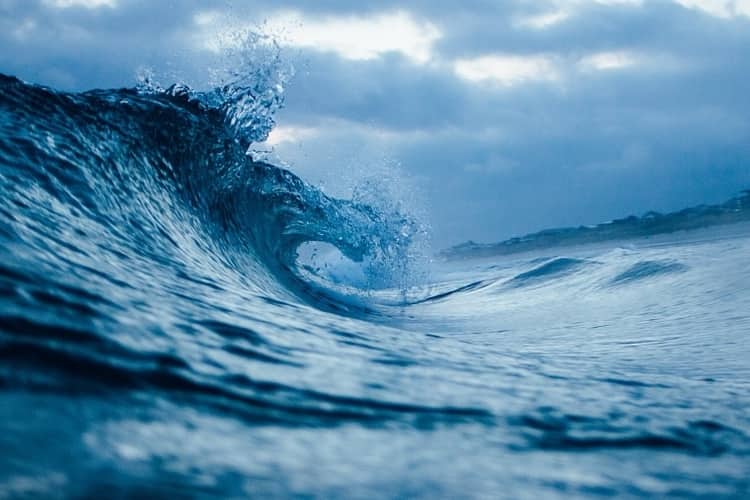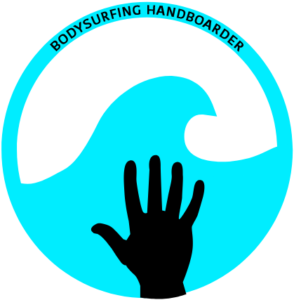
Want to know how to bodysurf with a handboard? If it is your first time then I totally understand that riding a wave with a hand plane can be a little intimidating, especially if you do not know what you are doing. To make things easier for you, I created this step-by-step guide where I cover all of the details so you can easily conquer your first waves.
step 1 – put on your gear before going into the ocean
There are two things to remember when you are putting on your bodysurfing gear:
- Put it on before entering the water
- Wear it correctly
It will prove to be much easier to put on your handboard (and swim fins) while sitting on dry land. This will prevent you from having to chase down your gear in case it unexpectedly floats away! I wrote a post on how to put on your handboard correctly for beginners so that your hand is placed in the right position to prevent injury.
If you are using a handboard leash, then you will also want to make sure it is secured to your arm before entering the water. Read my guide on where to place a handboard leash on your arm so it does not fall off. The correct arm placement will make a huge difference while bodysurfing.
step 2 – paddle or walk out to the breakers
Before you begin your journey out past the breaking waves, you want to make sure there is a lull in the set. This is the perfect time to swim out because the ocean is not producing any waves that could potentially push you back to shore.
It is easiest to walk out until the water is about chest or waist high. If the waves are breaking at this water level then you don’t need to go any further.
However, if the waves are breaking beyond chest-high level water, you will have to swim past the break. To do this, stretch the hand attached to your handboard out in front of you. Place your other hand on top of the hand in the strap. Your body will be fully stretched in a supine, aerodynamic position. Now kick your feet to propel yourself past the waves.
You can use the hand not strapped to your handboard to help paddle out by performing a freestyle crawl stroke. Your fingers should remain stuck together so you can cup the water and easily push it behind you. This will help you paddle out faster.
Pro tip #1: Make sure the handboard remains flat on the water surface and pointed forward to help keep you afloat and swimming in the correct direction.
Pro tip #2: When a wave approaches, kick under the water and keep the board pointed forward. The wave will simply flow over you.
Pro tip #3: If a set of waves do happen to form while walking out, remember to turn your shoulder into the wave to prevent yourself from getting knocked over backward.
step 3 – timing your wave
Wave timing can be challenging for beginner bodysurfer but it can make all the difference between a good day and bad one. If you time it too soon then you will end up in front of the wave. If you time it too late then the wave will roll over you.
The first thing you want to notice is how quickly the waves break and also the amount of time you have between sets. Sometimes you might have 5 seconds between waves so you need to make a quick decision on whether or not you are going to ride it. If the waves break quick, you need to be able to paddle furiously to catch it. so
You will become better at the timing as you spend more time in the ocean bodysurfing. Your best strategy to time a wave is to start swimming towards shore as you enter the trough of the wave. This is the bottom-most part of the wave that you will enter before it picks you up. If you begin your paddle at this time, your chances of dropping into the barrel are higher.
step 4 – dropping into the barrel
Once you have the correct wave timing down, your next focus is getting into the barrel. This means picking up the wave so you can bodysurf it on your handboard.
Here are a few different scenarios to consider…
dropping into the wave from standing position – if you are wading in chest high waiting for a wave, stretch your handboard out in front of you and push off ocean floor just before it breaks. This will give you excellent thrust to help you drop into the barrel. You may need to perform a few kicks and arm paddles for extra propulsion.
dropping into the wave while floating – From a floating position, you will rely solely on the power of your swimming ability. As the wave approaches, strecth out your handboard and start paddling furiously with your free hand and kicking fast before to drop intot he barrel.
In both scenarios, you want to make sure your last swiming stroke and kick thrusts you forward just before the wave breaks. This will allow you to slide down the wave face and drop successfully into the barrel.
step 5 – choosing a line
When you first pick of the wave you will be traveling straight towards shore but eventually, you will need to pick a line to the left or the right to keep riding the wave. So which direction do you bodysurf? There are a few different factors that come into play here. I will cover some of the thoughts I have when choosing my line.
wave direction – Which direction are the waves breaking? The ocean conditions may vary. Waves may be rolling in from left to right or vice versa. It is best to go with the grain and bodysurf in the same direction that the waves are breaking. This will give you the longest ride.
dominant hand – Most beginners wear their handboard on their dominant hand. I have found it easier to surf in the direction of the hand that my handboard is on.
For example, if I wear my handplane on my right hand, I typically surf the wave to the right. I like having the shoulder of my handboard hand closest to the wave face so I can lean into it. It also frees up my left hand to freely paddle instead of being restricted by the wave face.
Overall, choosing a specific direction will not impact your bodysurfing a whole lot since you will be riding small waves as a beginner. If you do happen to notice the wave set pulling significantly to the right or left, then bodysurf in the same direction as the wave break.
step 5 – planing after the wave picks you up
Once you feel the wave pick you up, you want to make your body straight like a surf board. You also want to place your paddling hand on top of the hand in the strap. Then push down on your handboard and lean into the wave face to get some speed.
Continue to lift your body up by pushing into the board until you feel yourself planing. The handboard provides lift and reduces drag to keep your body moving across the water surface.
Remember to keep your entire body straight and stiff, which makes for a more hydrodynamic position. Any additional movement will create drag and reduce your speed. Also, keep your hands out in front of you to protect your head and neck.
Note if you hit a flat spot in the wave start kicking again or use your legs to push off the ground. This will help to keep you moving along with it so you can ride it further.
Related Questions
Repositioning your body while using a handboard
It’s really easy for your body to get out of alignment when you are bodysurfing with a handboard. Fortunately, it is easy to reposition yourself while bodysurfing. Here are a few tips you can use to keep your body in line so you don’t wipe out.
use your fins – Believe it or not, you can use your fins to help redirect your body. They work the same way an oar does for a kayak.
Push down on the fin of the side you want to move towards. For example, if you want to move your body more to the right than let your right fin drag more than the left.
use your free hand – You can use your non-strapped, free hand to help reposition your body or stabilize yourself on your board. If you find yourself losing speed or drifting too far down or up the face, use your free arm to paddle in the desired direction or re-balance yourself.
engage core, arms, and legs – to maintain your balance and help realign the position of your body into a straight line, engage your core, grip, shoulders, and legs. For example, if you find one of your legs flailing out to the side, engage your muscles to bring it back next to your other one. If you find your board is sliding too far out in front of you, engage your core and lats to slide it back towards your chest.
how to turn with a handboard?
Turning your body while bodysurfing with a handboard is easy to learn but it may take a little time to get the feel for it. You simply lean into the edge of the board applying pressure with your hand in the direction you want to go. While you do this, point the nose of the board in that direction.
It may take a few practice runs to successfully master this. Remember that turning on each board will feel slightly different because of the design.
